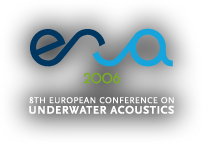

Comments: download pdf
file .
Ref.: Proc. ACOUSTICS'08, p. 670-674, Paris, France,2008.
Abstract
OFDM communication has recently been demonstrated in underwater channels at rates exceeding 7 kbps.
This is a popular modulation in wireless communications due to its flexibility for spectrum management and
the simplicity of transmitters/receivers.
Despite widespread interest, experimental data on the performance of underwater OFDM are scarce. This
work aims to contribute to a better understanding of this technique by examining results from the UAB’07
experiment, conducted in Norway in September 2007. Data were transmitted in a fjord using several formats
with bandwidths of 3 and 7.5 kHz, and recorded at a range of 800 m in a 16-hydrophone array. Significant
multipath was observed over at least 40 ms, which would call for a rather large OFDM prefix/guard interval
and hence drastically reduce the data rate. Passive time reversal is used here as a computationally inexpensive
scheme to shorten the channel length to less than 10 ms, so that moderate guard intervals can be used with
a conventional OFDM receiver. The same preamble/postamble signals used for synchronization and Doppler
precompensation are reused as probes for passive time reversal, so the latter entails no loss in efficiency.
The performance of time-reversed OFDM is compared with plain QPSK modulation using either time reversal
or multichannel equalization at the receiver.